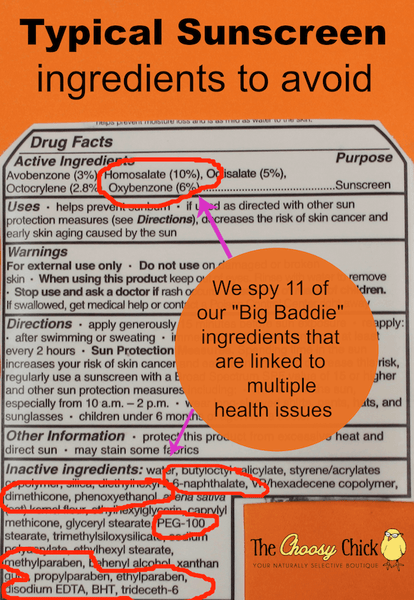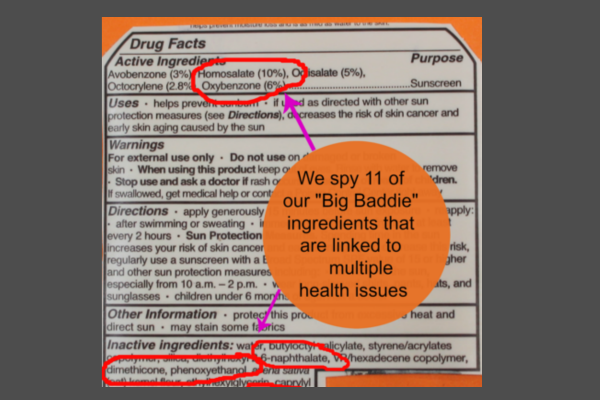When the weather gets warm, we all think about how to protect ourselves from the sun. But do you really know what's in your sunscreen? Chances are the sunscreen you have been using contains ingredients that are linked to numerous health issues and diseases. In fact, some of these ingredients disrupt hormones, cause allergic reactions, while others can affect the developing fetus. One in particular, Vitamin A derivative Retinyl Palmitate, can actually speed the development of skin cancer. And what is a hormone disruptor you ask? According to the National Institute of Health, hormone (endocrine) disruptors are chemicals that can interfere with the body's endocrine system and produce adverse developmental, reproductive, neurological, and immune effects in both humans and wildlife.
The Breast Cancer Fund states, “Research has found that many sunscreens contain chemicals that are estrogenic, disrupt the endocrine system and therefore can play a significant role in breast cancer development." Who would think that the products we use to prevent cancer may actually cause cancer?
Before you make your sunscreen purchase this year read the ingredient labels carefully and do not trust the claims displayed on the front. The picture below shows a label from a popular sunscreen marketed as being safe for babies. Note that there are chemicals of concern in both the active and inactive ingredient lists.

Active Ingredients:
Oxybenzone (benzophenone-3) - Easily absorbed through the skin and can cause changes in the body on a cellular level. In a study done by the CDC it was found in the urine of 95% of those tested. It is a hormone disruptor, linked to low birth-weight in babies and associated with photo-allergic reactions. Oxybenzone is found in high levels around tourist areas and destroying coral reefs.
Octinoxate (Octyl-methoxycinnamate) - Found in hundreds of sunscreens, this ingredient is estrogenic and is associated with thyroid hormone-disrupting effects. Found in breast milk.
Homosalate - Commonly found in sunscreens, this is a hormone-disrupting UVB blocker. According to EWG's Skin Deep, sunlight can actually break down this chemical into harmful by-products.
Nano-particles - Miniscule ingredient particles that are easily absorbed in the skin, and so small they can affect tissue on a cellular level. Not enough information is known about the effects of nanos although studies are underway about their safety and how they may adversely affect the body. Be aware of claims like "nano-technology". Opt for NON-NANO Titanium and Zinc Oxide.
Inactive Ingredients:
Retinyl Palmitate - This ingredient is commonly found in sunscreens and night creams that claim to turn back time and diminish wrinkles. It can actually make the skin MORE sensitive to the sun. According to the EWG's Guide to Safer Sunscreens, a federal study in 2010 showed that if applied in the sun, it may increase the risk of skin cancer tumors. Go figure! In addition, most obstetricians are recommending that pregnant women avoid the use of retinols as they may be toxic to the developing fetus when used on a daily basis. The EWG rates these baddies an 8 and recommends that consumers do NOT use them in products meant to be left on the skin. Related ingredient - Retinol
Parabens, PEGs, Fragrance, BHT, Phthalates, Phenoxyethanol - Found on the inactive ingredients list on sunscreen products and MANY other skincare products. Some of these are used as preservatives and cause hormone disruption, are linked to cancer and pose health concerns for babies. Please see our Big Baddies list for more detailed information on these ingredients.
Should you still use sunscreen?
Yes, but do your homework and choose wisely! The safest active ingredients for sun protection are large particle, non-nano zinc oxide and titanium dioxide. These will not penetrate the skin and provide great long-lasting protection. Read labels and avoid the unnecessary lengthy list of inactive ingredients. Also be wary of super high SPF claims as these are not any more effective and provide a false sense of security.
Our Safe Sunscreen Picks
We're proud of our collection of non-toxic, natural and organic sunscreen products in our Sun and Bug Protection Collection.



